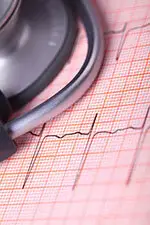 An arrhythmia is an irregular or abnormal heartbeat. An arrhythmia occurs when the electrical signals to the heart that coordinate its rhythm are not working properly. The term “arrhythmia” refers to any change from the normal sequence of electrical impulses, causing abnormal heart rhythms. Almost everyone’s heart skips or flutters at one time or another and these mild, one-time palpitations maybe harmless. But there are about 4 million Americans who have recurrent arrhythmias, and these people should be under the care of a doctor.
An arrhythmia is an irregular or abnormal heartbeat. An arrhythmia occurs when the electrical signals to the heart that coordinate its rhythm are not working properly. The term “arrhythmia” refers to any change from the normal sequence of electrical impulses, causing abnormal heart rhythms. Almost everyone’s heart skips or flutters at one time or another and these mild, one-time palpitations maybe harmless. But there are about 4 million Americans who have recurrent arrhythmias, and these people should be under the care of a doctor.
Your heart’s electrical system
The atria (the heart’s upper chambers) and ventricles (the heart’s lower chambers) work in concert, alternately contracting and relaxing to pump blood through the heart. The heart’s electrical system is the power source that generates your heartbeat. Your heartbeat is triggered by electrical impulses that travel down a special pathway through your heart. The impulse starts in a small bundle of specialized cells located in the right atrium, called the sinoatrial (SA) node. The SA node is also known as your heart’s natural pacemaker. The SA node sets the rate and rhythm of your heartbeat. Normal heart rhythm is often called normal sinus rhythm because the SA (sinus) node fires regularly.
Types of cardiac arrhythmias
Cardiac arrhythmias can be divided into categories based on their location and the rate of the arrhythmia:
- Supraventricular or Atria – Supraventricular arrhythmias happen in the structures above the ventricles, mainly the atria, which are the heart’s two upper chambers.
- Ventricular – Ventricular arrhythmias happen in the heart’s two lower chambers, called the ventricles.
- Tachycardia – Tachycardia is an arrhythmia which causes a very fast heart rate, meaning the heart beats in an abnormally rapid pattern–faster than 100 beats per minute. It can be atrial or ventricular in nature.
- Bradycardia – in this arrhythmia, you experience is a very slow heart rate. In bradycardia, the heart rate is less than 60 beats per minute.
Tachycardias in the atria:
- Atrial fibrillation is the most common type of arrhythmia (irregular heart beat). It is an irregular or quivering heartbeat in the upper chambers of the heart (atria), which results in the upper and the lower chambers of the heart not working together. Atrial fibrillation puts patients at risk for stroke, blood clots, and other heart related complications.
- Atrial flutter is similar to atrial fibrillation, it occurs in the upper chambers of the heart but unlike atrial fibrillation that is irregular atrial flutter is an abnormally fast regular pattern.
- Supraventricular Tachycardia (SVT), also called Paroxysmal (starts and stops without warning) Supraventricular Tachycardia, or Paroxysmal Atrial Tachycardia, is an episodic condition that causes a family of cardiac arrhythmias that cause abnormally fast heart rhythmrapid heart rate, more than 100 beats per minute, that originate in the upper chambers, or atria, of the heart. (“Supraventricular” means above the ventricles, “tachy” means fast, and “cardia” means heart.)
- Wolff-Parkinson-White (WPW) Syndrome is characterized as an abnormal electrical condition in the heart that may be associated with supraventricular tachycardia (fast heart rate originating above the ventricles). Wolff-Parkinson-White (WPW) Syndrome can cause 100 or more heart beats per minute. The fast heart rate, or tachycardia, can come and go suddenly.
Tachycardias in the ventricles:
- Ventricular Tachycardia, also known as V-tach or VT, is a rapid regular heart rhythm that occurs in the lower chambers of the heart.
- Ventricular fibrillation is a fast and chaotic quivering of the lower chambers in the heart which results in no blood flow from the heart. Unless promptly corrected, it leads to death.
Bradycardia – A slow heart rate
Heart Institute Quick Links
- Healthgrades™ 50 Best Award
- 2022 Cardiac Workshops
- 2020 Cardiac Workshops
- 2019 Cardiac Workshops
- Balloon Angioplasty
- Cardiac Arrhythmia Surgery
- Cardiac Catheterization
- Cardiac Educational Classes
- Cardiac Rehabilitation
- Cardiac Rehabilitation Outpatient
- Cardiovascular Surgery
- Coronary Artery Bypass Graft
- Coronary Artery Disease
- Coronary Artery Disease Diagnostic Testing
- ECMO
- Electrophysiology
- Heart and Cardiovascular Surgery
- Heart Rhythms Arrhythmias
- Heart Valve Repair
- Impella Left Ventricular Assist Device
- Implantable Cardioverter Defibrillator
- Off-Pump Coronary Bypass Surgery
- Pacemaker
- Peripheral Arterial Disease
- Stent Placement
- Supraventricular Tachycardia
- Transcatheter Aortic Valve Replacement (TAVR)
- Valve Disease
- Wolff Parkinson White Syndrome
